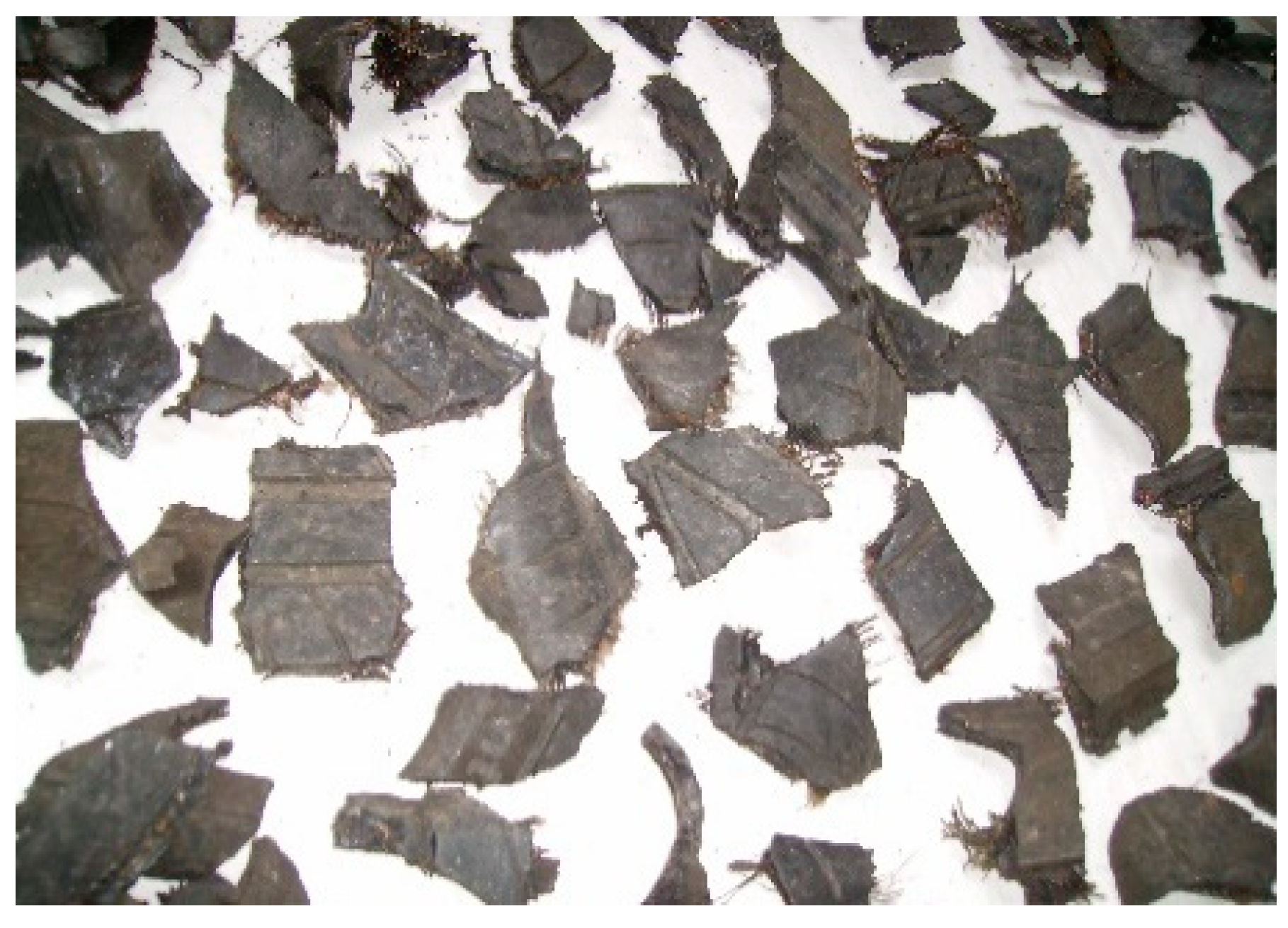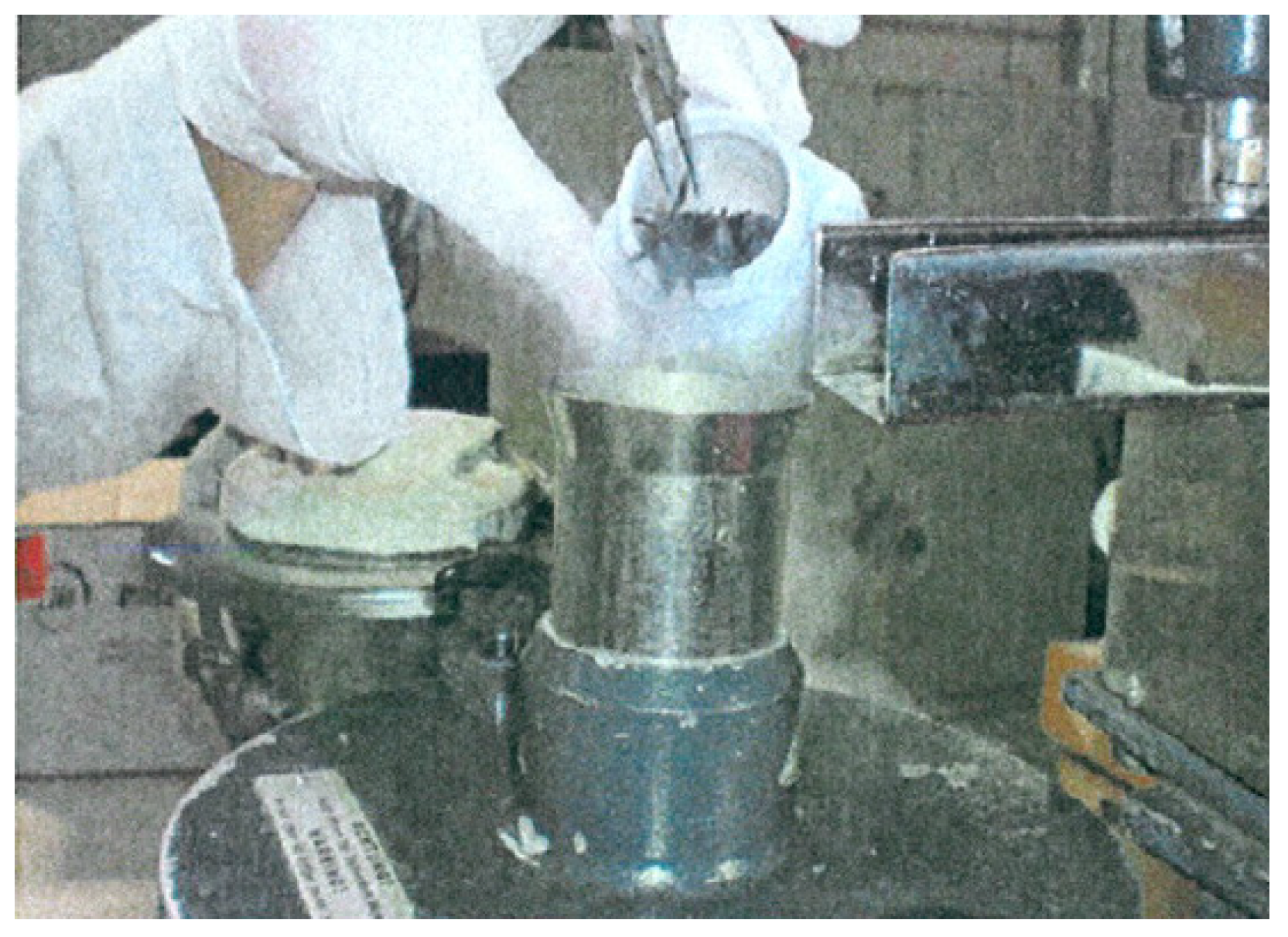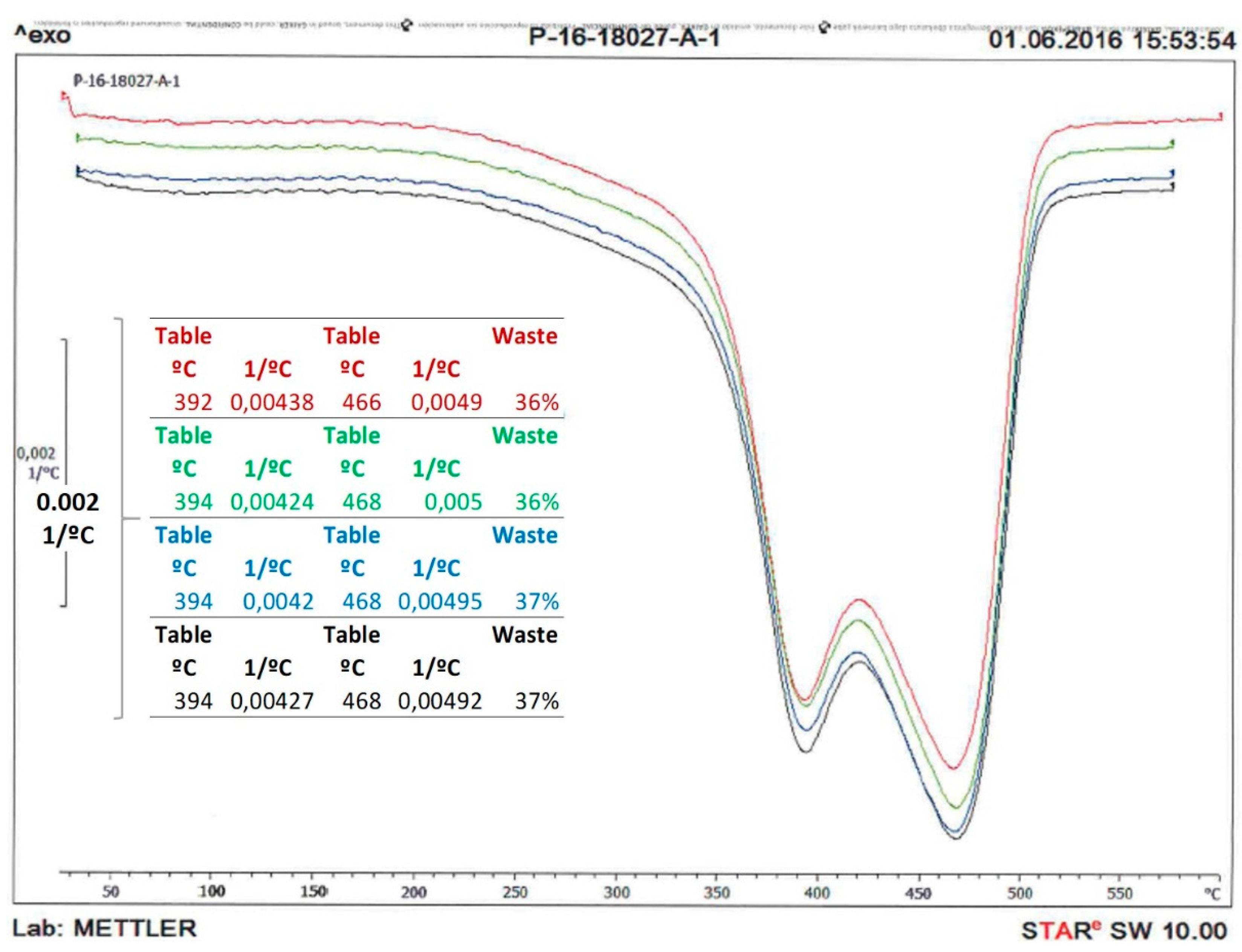Biomass Content in Scrap Tires and Its Use as Sustainable Energy Resource: A CO2 Mitigation Assessment
Abstract
1. Introduction
2. Materials and Methods
2.1. Sampling Scrap Tires and Characterization
2.2. Spanish Cement Sector as Case Study
2.3. Fuel Characterization
2.4. CO2 Emissions
3. Results
3.1. Thermogravimetric Analisys
- H1 is the maximum rate of mass loss versus temperature in the range 300–400 °C where the degradation of natural rubber occurs.
- H2 is the maximum mass loss rate versus temperature in the 420–500 °C range where the degradation of SBR rubber occurs.
3.2. Determination of Biomass in Scrap Tires, period 2010–2016
3.3. Calibration Line
3.3.1. Patterns, Data, and Composition
3.3.2. Determination of the Calibration Line
3.3.3. Analysis of Results of the Second Survey, 2011–2012
3.3.4. Analysis of Results of the Third Survey, 2013–2014
3.3.5. Analysis of Results of the Fourth Survey, 2015–2016
3.3.6. Undifferentiated Scrap Tire and Renewable Energy Assessment
3.4. CO2 Emissions
4. Conclusions
Author Contributions
Funding
Informed Consent Statement
Data Availability Statement
Acknowledgments
Conflicts of Interest
References
- Global Monitoring Laboratory. Available online: https://www.esrl.noaa.gov/gmd/ccgg/trends/index.html (accessed on 20 March 2019).
- Tobin, P.; Schmidt, N.M.; Tosun, J.; Burns, C. Mapping state’s Paris climate pledges: Analysing targets and groups at COP 21. Glob. Environ. Chang. 2018, 48, 11–21. [Google Scholar] [CrossRef]
- Pontzen, F.; Liebner, W.; Gronemann, V.; Rothaemel, M.; Ahlers, B. CO2-based methanol and DME—Efficient technologies for industrial scale production. Catal. Today 2011, 171, 242–250. [Google Scholar] [CrossRef]
- Directive 2003/87/EC of the European Parliament and of the Council of 13 October 2003. Available online: https://eur-lex.europa.eu/legal-content/EN/TXT/PDF/?uri=CELEX:32003L0087&from=EN (accessed on 22 March 2019).
- Directive 2009/28/EC of the European Parliament and of the Council of 23 April 2009. Available online: https://eur-lex.europa.eu/legal-content/EN/TXT/PDF/?uri=CELEX:32009L0028&from=EN (accessed on 22 March 2019).
- Stafford, F.N.; Dias, A.C.; Arroja, L.; Labrincha, J.A.; Hotza, D. Life cycle assessment of the production of Portland cement: A Southern Europe case study. J. Clean. Prod. 2016, 126, 159–165. [Google Scholar] [CrossRef]
- El Ouahrani, A.; Mesa, J.M.; Merzouki, A. Anthropogenic CO2 emissions from fossil fuels. Int. J. Clim. Chang. Strat. Manag. 2011, 3, 16–28. [Google Scholar] [CrossRef]
- Geissdoerfer, M.; Savaget, P.; Bocken, N.M.P.; Hultink, E.J. The Circular Economy—A new sustainability paradigm? J. Clean. Prod. 2017, 143, 757–768. [Google Scholar] [CrossRef]
- Huecker, S. Cradle to Cradle: Incorporating Natures´s Plan. Environ. Mag. 2007, 18, 35. [Google Scholar]
- Prieto-Sandoval, V.; Jaca, C.; Ormazabal, M. Towards a consensus on the circular economy. J. Clean. Prod. 2018, 179, 605–615. [Google Scholar] [CrossRef]
- Türkeli, S.; Kemp, R.; Huang, B.; Bleischwitz, R.; McDowall, W. Circular economy scientific knowledge in the European Union and China: A bibliometric, network and survey analysis (2006–2016). J. Clean. Prod. 2018, 197, 1244–1261. [Google Scholar] [CrossRef]
- Cetin, M. Landscape Engineering, Protecting Soil, and Runoff Storm Water; IntechOpen: London, UK, 2013; pp. 697–722. [Google Scholar]
- Rowhani, A.; Rainey, T.J. Scrap Tyre Management Pathways and Their Use as a Fuel—A Review. Energies 2016, 9, 888. [Google Scholar] [CrossRef]
- Cetin, M. Consideration of permeable pavement in landscape architecture. J. Environ. Prot. Ecol. 2015, 16, 385–392. [Google Scholar]
- Singh, R.K.; Ruj, B.; Jana, A.; Mondal, S.; Jana, B.; Sadhukhan, A.K.; Gupta, P. Pyrolysis of three different categories of automotive tyre wastes: Product yield analysis and characterization. J. Anal. Appl. Pyrolysis 2018, 135, 379–389. [Google Scholar] [CrossRef]
- Chatziaras, N.; Psomopoulos, C.S.; Themelis, N.J. Use of waste derived fuels in cement industry: A review. Manag. Environ. Qual. Int. J. 2016, 27, 178–193. [Google Scholar] [CrossRef]
- Quek, A.; Balasubramanian, R. Mathematical modeling of rubber tire pyrolysis. J. Anal. Appl. Pyrolysis 2012, 95, 1–13. [Google Scholar] [CrossRef]
- Communication from the Commission to the European Parliament, the Council, the European Economic and Social Committee and the Committee of the Regions—The Role of Waste-to-Energy in the Circular Economy. Available online: http://ec.europa.eu/environment/waste/waste-to-energy.pdf (accessed on 20 March 2019).
- Sarc, R.; Lorber, E.K.; Pomberger, R.; Rogetzer, M.; Sipple, E.M. Design, quality, and quality assurance of solid recovered fuels for the substitution of fossil feedstock in the cement industry. Waste Manag. Res. 2014, 32, 565–585. [Google Scholar] [CrossRef] [PubMed]
- Schneider, M. Process technology for efficient and sustainable cement production. Cem. Concr. Res. 2015, 78, 14–23. [Google Scholar] [CrossRef]
- Lamas, W.D.Q.; Palau, J.C.F.; De Camargo, J.R. Waste materials coprocessing in cement industry: Ecological efficiency of waste reuse. Renew. Sustain. Energy Rev. 2013, 19, 200–207. [Google Scholar] [CrossRef]
- Lecouls, H.; Klöpffer, W. Note on the critical review of the study “Life Cycle Assessment for the different used tyres recycling methods” prepared for Aliapur by Ecobilan. Int. J. Life Cycle Assess. 2010, 15, 893–895. [Google Scholar] [CrossRef]
- Genon, G.; Brizio, E. Perspectives and limits for cement kilns as a destination for RDF. Waste Manag. 2008, 28, 2375–2385. [Google Scholar] [CrossRef]
- Molino, A.; Donatelli, A.; Marino, T.; Aloise, A.; Rimauro, J.; Iovane, P. Waste tire recycling process for production of steam activated carbon in a pilot plant. Resour. Conserv. Recycl. 2018, 129, 102–111. [Google Scholar] [CrossRef]
- Plaza, M.G.; Martínez, S.; Rubiera, F. CO2 Capture, use, and Storage in the Cement Industry: State of the Art and Expectations. Energies 2020, 13, 5692. [Google Scholar] [CrossRef]
- Haneklaus, N.; Zheng, Y.; Allelein, H.-J. Stop Smoking—Tube-In-Tube Helical System for Flameless Calcination of Minerals. Processes 2017, 5, 67. [Google Scholar] [CrossRef]
- Mora, P.; Alarcón, A.; Tercero, S.; Llamas, B. Method to assess biomass in scrap tires: Spanish cement sector as a case study. Environ. Dev. Sustain. 2020, 1–18. [Google Scholar] [CrossRef]
- Dirección General de Tráfico. Available online: http://www.dgt.es/es/seguridad-vial/estadisticas-e-indicadores/parque-vehiculos/tablas-estadisticas (accessed on 16 February 2021).
- Januszewicz, K.; Klein, M. Thermogravimetric analysis/pyrolysis of used tyres and waste rubber. Physicochem. Probl. Miner. Process. 2017, 53, 802–811. [Google Scholar] [CrossRef]
- Han, J.; Li, W.; Liu, D.; Qin, L.; Chen, W.; Xing, F. Pyrolysis characteristic and mechanism of waste tyre: A thermogravimetry-mass spectrometry analysis. J. Anal. Appl. Pyrolysis 2018, 129, 1–5. [Google Scholar] [CrossRef]
- Islam, M.R.; Haniu, H.; Fardoushi, J. Pyrolysis kinetics behavior of solid tire wastes available in Bangladesh. Waste Manag. 2009, 29, 668–677. [Google Scholar] [CrossRef]
- Mikulčić, H.; Klemeš, J.J.; Vujanović, M.; Urbaniec, K.; Duić, N. Reducing greenhouse gasses emissions by fostering the deployment of alternative raw materials and energy sources in the cleaner cement manufacturing process. J. Clean. Prod. 2016, 136, 119–132. [Google Scholar] [CrossRef]
- Hendriks, C.; Worrell, E.; Price, L.; Martin, N.; Meida, L.O.; De Jager, D.; Riemer, P. Emission reduction of greenhouse gases from the cement industry. In Proceedings of the 4th International Conference on Greenhouse Gas Control Technologies, Interlaken, Austria, 13 July 2003; pp. 939–944. [Google Scholar] [CrossRef]
- Schneider, M.; Romer, M.; Tschudin, M.; Bolio, H. Sustainable cement production—Present and future. Cem. Concr. Res. 2011, 41, 642–650. [Google Scholar] [CrossRef]
- Energy Technology Perspectives 2012—Pathways to a Clean Energy System. Available online: https://www.iea.org/reports/energy-technology-perspectives-2012 (accessed on 2 April 2019).
- Machin, E.B.; Pedroso, D.T.; De Carvalho, J.A. Energetic valorization of waste tires. Renew. Sustain. Energy Rev. 2017, 68, 306–315. [Google Scholar] [CrossRef]
- Cooper, C.D.; Kim, B.; Macdonald, J. Estimating the Lower Heating Values of Hazardous and Solid Wastes. J. Air Waste Manag. Assoc. 1999, 49, 471–476. [Google Scholar] [CrossRef]
- Clark, G.M. Burning Tires for Fuel and Tire Pyrolysis: Air Implications; Durham University: Durham, UK, 1999; p. 140. [Google Scholar]
- Savitsky, D.P.; Stanishevskii, Y.M.; Gizha, S.S.; Tur’Yanskii, A.G. Desulfurization of Brown Coal in Water under Supercritical Conditions. Solid Fuel Chem. 2018, 52, 143–152. [Google Scholar] [CrossRef]
- Dmitrienko, M.A.; Nyashina, G.S.; Strizhak, P.A. Major gas emissions from combustion of slurry fuels based on coal, coal waste, and coal derivatives. J. Clean. Prod. 2018, 177, 284–301. [Google Scholar] [CrossRef]
- Wang, R.; Zhao, Z.; Liu, J.; Lv, Y.; Ye, X. Enhancing the storage stability of petroleum coke slurry by producing biogas from sludge fermentation. Energy 2016, 113, 319–327. [Google Scholar] [CrossRef]
- Zhang, Q.; Tian, W.; Zheng, Y.; Zhang, L. Fuel consumption from vehicles of China until 2030 in energy scenarios. Energy Policy 2010, 38, 6860–6867. [Google Scholar] [CrossRef]
- Nukman, S.R.; Yani, I.; Arief, T. The blending effect of coalite, coconut shell charcoal and gelam wood charcoal on calorific value. Am. J. Appl. Sci. 2014, 11, 833–836. [Google Scholar] [CrossRef][Green Version]
- Štícha, V.; Macků, J.; Zahradník, D.; Klvač, R.; Nuhlíček, O.; Ruman, D. Seasoning Poplar (Populus maximowiczii × Populus nigra ´Max 4–5´) Wood using Evapotranspiration. BioResources 2018, 13, 7496–7507. [Google Scholar] [CrossRef]
- MAPAMA. Fabricación de Cemento (Combustión). Available online: https://www.mapama.gob.es/es/calidad-yevaluacion-ambiental/temas/sistema-espanol-de-inventario-sei-/030311-combust-fabric-cemento_tcm30-430164.pdf (accessed on 17 February 2021).





| 2010 | 2011 | 2012 | 2013 | 2014 | 2015 | 2016 | |
|---|---|---|---|---|---|---|---|
| ABOÑO | 2.791 | 6.255 | 4.700 | 3.366 | 0.791 | 0.284 | 0.200 |
| ALICANTE | 8.208 | 5.955 | 4.069 | 6.286 | 6.903 | 0.920 | 0 |
| AÑORGA | 6.344 | 6.128 | 4.978 | 4.822 | 7.308 | 5.458 | 9.845 |
| CARBONERAS | 2.56 | 0.011 | 0.553 | ||||
| CASTILLEJO | 7.592 | 6.526 | 9.142 | ||||
| CÓRDOBA | 0.002 | ||||||
| GADOR | 4.963 | 4.824 | 4.026 | 3.148 | 3.718 | 3.899 | 2.285 |
| HONTORIA | 1.943 | 2.242 | 1.012 | 1.282 | 1.006 | 0.915 | |
| JEREZ | 3.977 | 2.643 | 1.463 | 2.282 | 0.158 | 2.029 | 4.787 |
| LA ROBLA | 28.074 | 32.590 | 31.509 | 26.841 | 22.620 | 11.890 | 22.626 |
| LEMONA | 6.679 | 8.826 | 7.197 | 5.068 | 7.160 | 1.202 | 6.682 |
| LLOSETA | |||||||
| LORCA | 0.068 | 0.188 | 0.293 | ||||
| MALAGA | 17.657 | 20.259 | 15.171 | 16.007 | 31.520 | 37.092 | 46.605 |
| MATAPORQUERA | 4.986 | 6.710 | 4.041 | 1.744 | 1.860 | 1.110 | |
| MORATA DE TAJUÑA | 3.180 | 4.558 | 5.454 | 4.412 | |||
| OURAL | 0.444 | 0.030 | |||||
| SAGUNTO | 18.756 | 15.405 | 13.445 | 12.905 | 14.783 | 12.941 | 13.915 |
| SAN VICENC DEL HORTS | 0.378 | 4.980 | |||||
| TORAL DE LOS VADOS | 0.011 | ||||||
| VILLALUENGA | 8.293 | 10.926 | 8.493 | 10.279 | 12.310 | 12.741 | 13.922 |
| YELES | 0.434 | 1.033 | 0.698 | ||||
| TOTAL | 116.396 | 128.509 | 115.133 | 99.267 | 114.855 | 97.154 | 132.286 |
| Light Vehicles | Heavy Vehicles | ||||||
|---|---|---|---|---|---|---|---|
| NR | SBR | BC | NR | SBR | BC | ||
| Survey 1 (2010) | Max. | 19.90 | 49.94 | 36.25 | 64.45 | 40.00 | 37.00 |
| Min. | 13.81 | 45.10 | 35.00 | 22.50 | 4.62 | 32.00 | |
| Average | 16.97 | 47.40 | 35.63 | 49.27 | 16.53 | 34.50 | |
| Standard deviation | 2.02 | 1.72 | 0.44 | 14.83 | 12.56 | 2.07 | |
| Survey 2 (2011–2012) | Max. | 24.43 | 41.92 | 39.25 | 30.27 | 40.16 | 38.49 |
| Min. | 19.07 | 38.55 | 36.99 | 23.53 | 33.40 | 35.49 | |
| Average | 22.46 | 46.13 | 41.14 | 27.33 | 43.50 | 43.51 | |
| Standard deviation | 1.23 | 0.99 | 0.75 | 1.90 | 1.81 | 0.86 | |
| Survey 3 (2013–2014) | Max. | 28.93 | 39.44 | 37.48 | 45.59 | 32.09 | 35.24 |
| Min. | 23.54 | 34.27 | 35.74 | 33.26 | 19.48 | 33.74 | |
| Average | 25.72 | 37.53 | 36.72 | 39.04 | 26.43 | 34.33 | |
| Standard deviation | 1.37 | 1.27 | 0.49 | 3.70 | 3.51 | 0.47 | |
| Survey 4 (2015–2016) | Max. | 26.80 | 40.99 | 37.25 | 44.46 | 28.86 | 35.75 |
| Min. | 22.49 | 36.42 | 36.00 | 35.31 | 21.26 | 33.75 | |
| Average | 24.96 | 38.98 | 35.63 | 41.47 | 24.09 | 34.33 | |
| Standard deviation | 1.21 | 1.31 | 0.37 | 2.97 | 2.57 | 0.54 | |
| Light Vehicles | ||||
|---|---|---|---|---|
| NR | SBR | BC | ||
| Survey 3 (2013–2014) | Max. | 25.47 | 39.37 | 38.00 |
| Mono-brand samples | Min. | 22.62 | 39.02 | 35.49 |
| Average | 24.05 | 39.20 | 36.75 | |
| Standard deviation | 2.02 | 0.25 | 1.77 | |
| PATTERN SAMPLES | H1/H2 | NR/(SBR+NR) |
|---|---|---|
| 52% NR + 13% SBR | 2.106 | 80% |
| 39% NR + 26% SBR | 1.503 | 60% |
| 26% NR + 39% SBR | 0.900 | 40% |
| 13% NR + 52% SBR | 0.297 | 20% |
| 35% NR + 30% SBR | 1.318 | 54% |
| 42% NR + 23% SBR | 1.642 | 65% |
| 30% NR + 35% SBR | 1.085 | 46% |
| Light Vehicles (%) | Heavy Vehicles (%) | |
|---|---|---|
| Survey 1 (2010) | 57.40 | 42.60 |
| Survey 2 (2011–2012) | 57.66 | 42.34 |
| Survey 3 (2013–2014) | 58.57 | 41.43 |
| Survey 4 (2015–2016) | 57.58 | 42.42 |
| AVERAGE | 57.80 | 42.20 |
| Biomass Content (%) | Kg Biomass NFU | Energy (MJ) | |
|---|---|---|---|
| Survey 1 (2010) | 30.73 | 35,769.08 | 1,251,917.95 |
| Survey 2 (2011–2012) | 24.52 | 59,743.73 | 2,091,030.64 |
| Survey 3 (2013–2014) | 31.24 | 66,888.29 | 2,341,090.09 |
| Survey 4 (2015–2016) | 31.96 | 73,326.93 | 2,566,442.43 |
| AVERAGE | 29.61 | 58,932.01 | 1,894,679.56 |
Publisher’s Note: MDPI stays neutral with regard to jurisdictional claims in published maps and institutional affiliations. |
© 2021 by the authors. Licensee MDPI, Basel, Switzerland. This article is an open access article distributed under the terms and conditions of the Creative Commons Attribution (CC BY) license (http://creativecommons.org/licenses/by/4.0/).
Share and Cite
Mora, P.; Alarcón, A.; Sánchez-Martín, L.; Llamas, B. Biomass Content in Scrap Tires and Its Use as Sustainable Energy Resource: A CO2 Mitigation Assessment. Sustainability 2021, 13, 3500. https://doi.org/10.3390/su13063500
Mora P, Alarcón A, Sánchez-Martín L, Llamas B. Biomass Content in Scrap Tires and Its Use as Sustainable Energy Resource: A CO2 Mitigation Assessment. Sustainability. 2021; 13(6):3500. https://doi.org/10.3390/su13063500
Chicago/Turabian StyleMora, Pedro, Arturo Alarcón, Laura Sánchez-Martín, and Bernardo Llamas. 2021. "Biomass Content in Scrap Tires and Its Use as Sustainable Energy Resource: A CO2 Mitigation Assessment" Sustainability 13, no. 6: 3500. https://doi.org/10.3390/su13063500
APA StyleMora, P., Alarcón, A., Sánchez-Martín, L., & Llamas, B. (2021). Biomass Content in Scrap Tires and Its Use as Sustainable Energy Resource: A CO2 Mitigation Assessment. Sustainability, 13(6), 3500. https://doi.org/10.3390/su13063500





